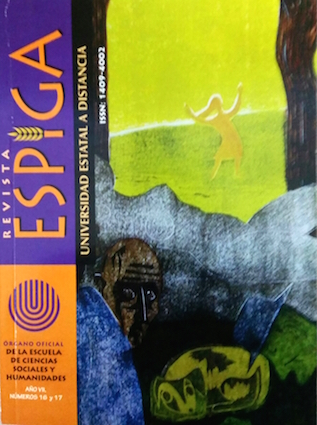Características de la agrobiotecnología
DOI:
https://doi.org/10.22458/re.v8i16.1530Palabras clave:
Agrobiotecnología, transgénicos, transnacionales, agroecología, soberanía.Resumen
Las semillas transgénicas, una innovación biotecnológica, representan tanto promesas como peligros para los agricultores, los consumidores y el ambiente...y vislumbran ganancias multimillonarias para las empresas transnacionales. Pero como técnica nueva, todavía no se sabe las consecuencias sobre el largo plazo ni aun el plazo inmediato, pues existen muchos peligros para la salud humana y el ambiente. Las políticas neoliberales y transnacionales destruyen la soberanía alimentaria, por eso deben sentir el impacto de los movimientos ambientalistas, laborales y campesinos, de modo que reorienten su trabajo para el beneficio de toda la sociedad y de la naturaleza.
Citas
ALTIERI, M. (1999). Biotecnología agrícola: mitos, riesgos ambientales y alternativas. Universidad de California, Berkeley. PEDCLADES / FOOD FIRST.
ALTIERI, M. y et al. (2000). Agroecología: bases científicas para una agricultura Sustentable. Uruguay: Ed. Nordan- Comunidad.
AUDIRAC, Y. (1997). Rural sustainable development in America. New York: John Wiley and Sons.
BOUCHER, D.H. (ed.) (1999). The Paradox of Plenty: Hunger in a Bountiful World. Oakland, CA: Food First Books.
CONWAY, G.R. (1997). The Doubly Green Revolution: Food for All in the 21st Century. London, UK: Penguin Books.
FAO (2004). Seguridad Alimentaria Mundial y Plan de Acción Mundial sobre la Alimentación. Roma, FAO.
FOWLER, C. and Mooney, P. (1990). Shattering: Food, Politics, and the Loss of Genetic Diversity. Tucson: University of Arizona Press.
GRESSHOFF, P.M. (1996). Technology transfer of plant biotechnology. Boca Raton, CRC Press,
KLOPPENBURG, J. (1998). Biotechnology to the rescue? Twelve reasons why biotechnology is incompatible with sustainable agriculture. The Ecologist. 26:61-67.
LAMPKIN, N. (1990). Organic Farming. Ipswich, NY: Farming Press.
LAPPE, F.M. et al. (1998). World Hunger: Twelve Myths. (second edition), p. 270. New York: Grove Press.
LEVIDOW, L. and S. Carr. (1997). How biotechnology regulation sets a risk / ethics boundary. Agriculture and Human Values 14: 29-43.
LIPTON, M. (1989). New seeds and poor people. Baltimore. The John Hopkins University Press, National Research Council. (1996). Ecologically Based Pest Management. Washington, DC. National Academy of Sciences.
PENGUE, W. (2000). Cultivos Transgénicos. Lugar Editorial, Argentina.
PERSLEY, G.J. et al. (2000). Agricultural Biotechnology and the Poor. Washington DC: Consultative Group on International Agricultural Research.
PIMENTEL, D. et al. (1993). The pesticida question. New York: Chapman and Hall..
PRETTY, J. (1995). Regenerating Agriculture: Policies and Practices for Sustainability and Self-reliance. London, UK: Earthscan.
RISSLER, J. and M. Mellon. (1996). The Ecological Risks of Engineered Crops. Cambridge, MA: MIT Press.
ROBINSON, R.A. (1996). Return to Resistance: Breeding Crops to Reduce Pesticide Resistance. Davis, California: AgAccess.
ROSSET, P. (1999). The multiple functions and benefits of small farm agriculture in the context of global trade negotiations. Food First Policy Brief n.° 4. Oakland, CA: Institute for Food and Development Policy.
SNOW, A.A. and P. Moran. (1997). Commercialization of transgenic plants: potentialecological risks. BioScience 47: 86- 96.
THRUPP, L.A. (1998). Cultivating Biodiversity: Agrobiodiversity for Food Security. Washington DC: World Resources Institute.
TOLEDO, V.M. (1990). Modernidad y Ecología: la nueva crisis planetaria. En Ecología Política n.º 3; pp.9-22.
WEBBER, D.J. (ed). (1990). Biotechnology: assessing social impacts and policy implications. Greenwood Press, Westport, CT.
WORLD WILDLIFE FUND – WWF (2006). Living Planet Report.
Descargas
Publicado
Cómo citar
Número
Sección
Licencia
Los artículos publicados por esta revista operan bajo licencia de CREATIVE COMMONS (Atribución-NoComercial-CompartirIgual 4.0). El Comité Editorial permite la reproducción parcial o total de los artículos a condición de que se mencione la fuente. Asimismo, los escritos podrán ser colgados y divulgados vía digital, siempre y cuando se mantenga la fuente de su publicación.
